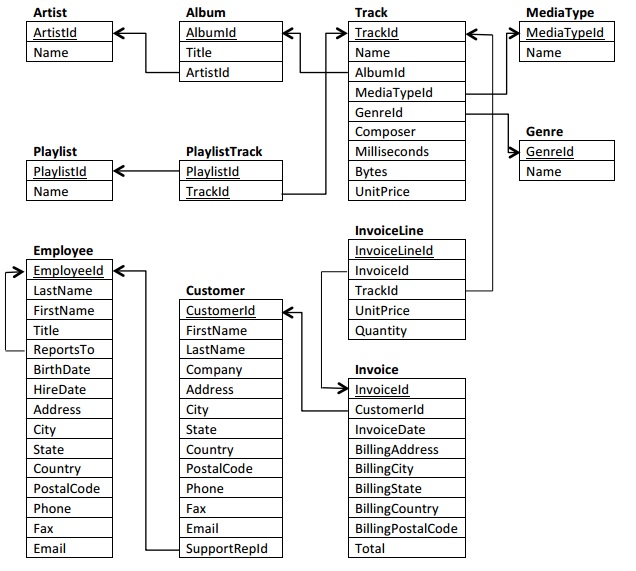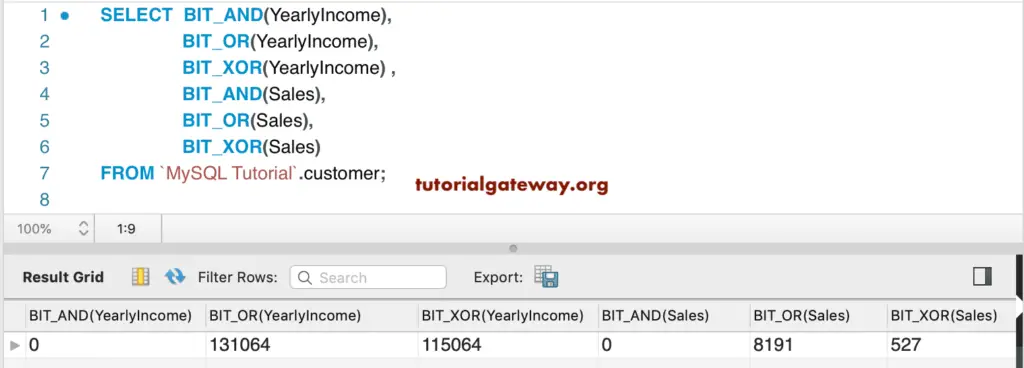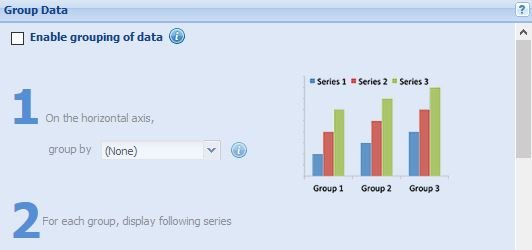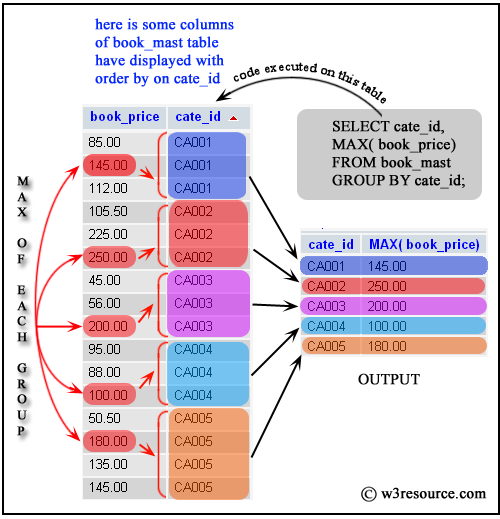They are commonly used with the GROUP BY clause in a SELECT statement, where Oracle Database divides the rows of a queried table or view into groups. In a query containing a GROUP BY clause, the elements of the select list can be aggregate functions, GROUP BY expressions, constants, or expressions involving one of these. Oracle applies the aggregate functions to each group of rows and returns a single result row for each group. An aggregate function computes a single result from multiple input rows. For example, there are aggregates to compute the count, sum, avg, max and min over a set of rows. Expression_n Expressions that are not encapsulated within an aggregate function and must be included in the GROUP BY Clause at the end of the SQL statement.
Aggregate_function This is an aggregate function such as the SUM, COUNT, MIN, MAX, or AVG functions. Aggregate_expression This is the column or expression that the aggregate_function will be used on. Tables The tables that you wish to retrieve records from. There must be at least one table listed in the FROM clause.
These are conditions that must be met for the records to be selected. The expression used to sort the records in the result set. If more than one expression is provided, the values should be comma separated. ASC sorts the result set in ascending order by expression. This is the default behavior, if no modifier is provider. DESC sorts the result set in descending order by expression.
Common aggregate functions include SUM, AVG, MIN, MAX, and COUNT. Any column or expression in your SELECT clause must also be listed in the GROUP BY clause. The ALL and DISTINCT keywords are optional, and perform as they do with the SELECT clauses that you have learned to write. The ALL keyword is the default where the option is allowed.
The expression listed in the syntax can be a constant, a function, or any combination of column names, constants, and functions connected by arithmetic operators. However, aggregate functions are most often used with a column name. Except COUNT function, all the aggregate functions do not consider NULL values.
The SQL GROUP BY Statement The GROUP BY statement groups rows that have the same values into summary rows, like "find the number of customers in each country". The GROUP BY statement is often used with aggregate functions to group the result-set by one or more columns. The filter clause extends aggregate functions (sum, avg, count, …) by an additional where clause. The result of the aggregate is built from only the rows that satisfy the additional where clause too. Spark also supports advanced aggregations to do multiple aggregations for the same input record set via GROUPING SETS, CUBE, ROLLUP clauses.
The grouping expressions and advanced aggregations can be mixed in the GROUP BY clause and nested in a GROUPING SETS clause. See more details in the Mixed/Nested Grouping Analytics section. When a FILTER clause is attached to an aggregate function, only the matching rows are passed to that function.
Aggregate functions summarize data over groups of rows from a query result set. They are allowed only in the select list and in the HAVING and ORDER BY clauses of a SELECT statement . An aggregate function refers to a set of input values and returns one single result value.
If the table is subdivided into several groups with the GROUP BY clause, an aggregate function calculates a value for each of these groups. The GROUP BY Clause is used together with the SQL SELECT statement. The SELECT statement used in the GROUP BY clause can only be used contain column names, aggregate functions, constants and expressions. SQL Having Clause is used to restrict the results returned by the GROUP BY clause. Aggregate functions group multiple input records to form a single output record. The GROUP BY clause will group records in a result set by identical values in one or more columns.
It is often used in combination with aggregate functions to query information of similar records. The GROUP BY clause can come after FROM or WHERE but must come before any ORDER BY or LIMIT clause. It is not permissible to include column names in a SELECT clause that are not referenced in the GROUP BY clause. The only column names that can be displayed, along with aggregate functions, must be listed in the GROUP BY clause. Since ENAME is not included in the GROUP BYclause, an error message results.
If a GROUP BY clause is not stated, an aggregate function always refers to the entire table. Aggregate functions are sometimes referred to as set functions. (column \"candidates.id\" must appear in the GROUP BY clause or be used in an aggregate function",) 0 I have 2 tables, agents and candidates. When the query executes, the rows are aggregated by department. The innermost group function, in this case the SUM function, is used to generate one salary value per department.
This is no different than in previous examples, but this time you have a MAX function seemingly left over. That MAX function is applied to the entire collection of SUMvalues produced by the initial aggregation. The result is a single value, the maximum amount of money that any one department spends on employee salaries, which is just what your CEO wanted. The HAVING clause is used to further filter the result set groups provided by the GROUP BY clause. HAVING is often used with aggregate functions to filter the result set groups based on an aggregate property.
The given query will select only the records from only years where more than 5 movies were released per year. The AVG() aggregate function returns the average value in a column. For instance, to find the average salary for the employees who have less than 5 years of experience, the given query can be used. The query seems pretty logical; we're adding a new column, "rn," that is essentially a pseudo-sequence. The result set is partitioned by city and reverse ordered by amount.
But, Snowflake and all other databases/data warehouses don't accept a window function in a group by clause, returning a similar error as above. The BIT_AND(), BIT_OR(), and BIT_XOR() aggregate functions perform bit operations. Prior to MySQL 8.0, bit functions and operators required BIGINT (64-bit integer) arguments and returned BIGINT values, so they had a maximum range of 64 bits. Non-BIGINT arguments were converted to BIGINT prior to performing the operation and truncation could occur.
Therefore, COUNTreturns 4, whereas COUNT andCOUNT both return 20. The aggregate functions do not include rows that have null values in the columns involved in the calculations; that is, nulls are not handled as if they were zero. The COUNT() aggregate function returns the total number of rows that match the specified criteria. For instance, to find the total number of employees who have less than 5 years of experience, the given query can be used.
Functions for computing a single result from a set of input values. Elasticsearch SQL supports aggregate functions only alongside grouping . The WHERE clause in MySQL is used with SELECT, INSERT, UPDATE, and DELETE queries to filter data from the table or relation.
It describes a specific condition when retrieving records from a single table or multiple tables using the JOIN clause. If the specified condition is satisfied, it returns the particular value from the table. The WHERE clause places conditions on the selected columns. SQL has numerous predefined aggregate functions that can be used to write queries to produce exactly this kind of information.
Stddev_pop() function returns the population standard deviation of the values in a column. Stddev_samp() function returns the sample standard deviation of values in a column. All these aggregate functions accept input as, Column type or column name in a string and several other arguments based on the function and return Column type. Description All aggregate functions support filter expressions. If you specify a filter condition, only the row data that meets the filter condition can be passed to the related aggregate function for data processing.
It is therefore possible that another user may be performing a transaction that modifies the data while an aggregate calculation is in process. In this query, all rows in the EMPLOYEE table that have the same department codes are grouped together. The aggregate function AVG is calculated for the salary column in each group. The department code and the average departmental salary are displayed for each department.
In this article, we have made a comparison between the WHERE and HAVING clause. Here, we conclude that both clauses work in the same way in filtering the data, except some additional feature makes the HAVING clause more popular. We can efficiently work with aggregate functions in the HAVING clause while WHERE does not allow for aggregate functions. HAVING clause in MySQL used in conjunction with GROUP BY clause enables us to specify conditions that filter which group results appear in the result. It returns only those values from the groups in the final result that fulfills certain conditions. We can also use the WHERE and HAVING clause together during selection.
In this case, WHERE clause first filters the individual rows, then rows are grouped, performs aggregate calculations, and at last HAVING clause filter the groups. They return a single value for each row, in contrast to aggregate functions which returns a single value for a group of rows. Spark SQL provides built-in standard Aggregate functions defines in DataFrame API, these come in handy when we need to make aggregate operations on DataFrame columns. Aggregate functions operate on a group of rows and calculate a single return value for every group.
In the preceding example, the HAVING clause refers toCOUNT, which is not in the SELECT list. You are not required to show in your result set all the columns or expressions that determine which rows end up in that result set. SQL allows the user to store more than 30 types of data in as many columns as required, so sometimes, it becomes difficult to find similar data in these columns. Group By in SQL helps us club together identical rows present in the columns of a table.
This is an essential statement in SQL as it provides us with a neat dataset by letting us summarize important data like sales, cost, and salary. While all aggregate functions could be used without the GROUP BY clause, the whole point is to use the GROUP BY clause. That clause serves as the place where you'll define the condition on how to create a group.
When the group is created, you'll calculate aggregated values. While the first query is not needed, I've used it to show what it will return. I did that because this is what the second query counts.
The MIN() aggregate function returns the smallest value in a column. For instance, to find the smallest value of the amount column from the table named transactions, the given query can be used. The GROUP BY clause divides the rows returned from the SELECTstatement into groups. For each group, you can apply an aggregate function e.g.,SUM() to calculate the sum of items or COUNT()to get the number of items in the groups. Aggregate functions don't accept nested aggregate functions or window functions as arguments.
The WHERE clause is applied before aggregate functions are computed , so it's impossible to use an aggregate function in a WHERE clause. You can sometimes get around that by using an aggregate function in a sub-query, and use the value it returns in the WHERE clause of a super-query. Takes two column names or expressions as arguments, the first of these being used as a key and the second as a value, and returns a JSON object containing key-value pairs. Returns NULL if the result contains no rows, or in the event of an error. An error occurs if any key name is NULL or the number of arguments is not equal to 2.
An aggregate function is a function that summarizes the rows of a group into a single value. We cannot use the WHERE clause with aggregate functions because it works for filtering individual rows. In contrast, HAVING can works with aggregate functions because it is used to filter groups. A HAVING clause filters rows AFTER the GROUPING action (i.e., after the calculation of the aggregate functions). A WHERE clause is used to filter rows BEFORE the GROUPING action (i.e., before the calculation of the aggregate functions).
SumDistinct() function returns the sum of all distinct values in a column. Avg() function returns the average of values in the input column. Do all columns in a SELECT list have to appear in a GROUP BY , a_id; it doesn't have to appear in the -- GROUP BY clause. It lets you omit just about everything from the GROUP BY. But that design choice makes its behavior indeterminate when you omit columns that are in the SELECT list. Oracle provides a rich set of features to handle group operations.
These features include aggregate functions, the GROUP BY clause, the HAVING clause, and the extensions to the GROUP BY clause—ROLLUP, CUBE, and GROUPING SETS. The Group By statement is used to group together any rows of a column with the same value stored in them, based on a function specified in the statement. Generally, these functions are one of the aggregate functions such as MAX() and SUM().
Aggregate functions operate on a set of rows and return a single result. Aggregate functions are often used in conjunction with GROUP BY and HAVING clauses in the SELECT statement. While these values don't have any practical use, this shows the power of aggregate functions.



























